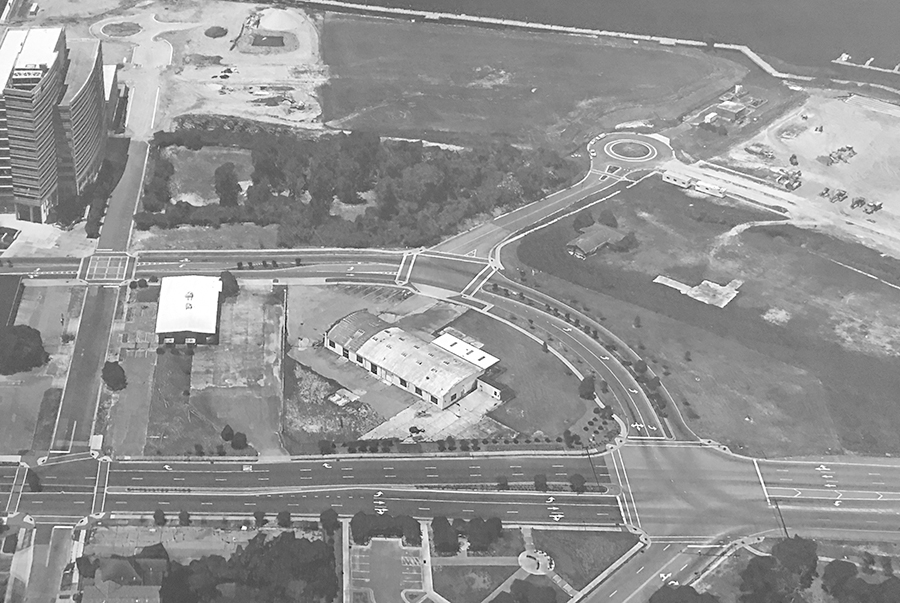Talented North Carolina architects recently spent two days rethinking the future look and function of the Port City — knitting us together one neighborhood at a time
By J. Michael Welton
For two days in mid-September, 35 architects from across North Carolina studied, reimagined and redrew two neglected areas of downtown Wilmington. The results were engaging and dynamic — and offer potential glimpses into the future of the city’s built environment.
The architects were working at the request of city planners in a design charrette — or workshop — organized by the North Carolina chapter of the American Institute of Architects. A charrette is an intense, deadline-driven exercise with a distinctly French pedigree. It draws its name from the 19th century Ecole des Beaux-Arts in Paris, and literally means “cart” in French. It’s named after the receptacle into which drawings were dropped at the end of a day-long student workshop.
A freight line turned trolley
In one case, the architects and planners were working to rethink the CSX freight line that runs through much of the downtown core, in a loop that some liken to the St. Louis Arch laid sideways. The rail line moves freight in containers from the port of Wilmington along 32 stops in the city, disrupting traffic all along the way.
That can mean a 20-minute delay at some stops. “To get to the south side where the rail and shipyard is, it has to go through the city fabric,” says Chad Volk of Davis Kane Architects in Raleigh. “It goes through traffic, and as the city grows, it’s causing traffic and transportation problems.”
There’s a proposal on the table to move the rail line across the Cape Fear River, and the city is interested in what kind of public transportation options could take its place once it’s gone. One option might be a trolley that moves people, rather than freight, throughout downtown. “The train bed is already there, so you don’t have to build anything from scratch,” says Raleigh architect Bob Andron of Andron Architects and Associates. “They can open up the existing track for trolley service — it’s already set up to go around town on the same track that’s in use now.”
As it stands now, the rail line south of downtown cuts off a number of neighborhoods from one another, creating disconnection and isolation for residents. But a repurposed trolley could knit the neighborhoods back together, reconnecting them on a physical and psychological level — and open up downtown to their residents. A trolley also would mean fewer cars in the city, with cleaner air and less carbon. “It’s such a clean solution — it’s about making Wilmington a much more livable environment,” says Andron.
Volk, Andron and their team also focused on stations, stops and platforms for the Southside area that’s about a mile from downtown. “We looked at existing neighborhoods and certain streets and existing buildings, both commercial and residential, for potential stops or stations,” Volk says. “We were trying to make connections with the existing fabric and buildings in the community, so people would say: ‘I know that building — or that park!’”
The idea was not to force a new name on the neighborhood, but to reference certain components to give it a sense of place while providing public transportation. “It’s a whole way of repurposing the railway to bring the community together and get them to places they couldn’t get to before, like areas of downtown with jobs or other opportunities,” Volk says.
Bottom-up design
While Volk, Andron and others looked at potential stops and stations, a group of seven students from N.C. State’s College of Design was engaged in a new, bottom-up initiative called public interest design. Led by N.C. State professor Bryan Bell, the students met in a neighborhood church with 50 residents from Southside neighborhoods. Their aim: to solicit the community’s wants and needs, should the CSX line move across the river.
The residents were wary. CSX already had held an earlier public meeting to announce its intent to close off streets in a 10-block neighborhood. That plan was met with little enthusiasm — and no small amount of suspicion.
“At the beginning, they were a little nervous and uncomfortable — they thought a lot of things had been hidden from them, and that something was not going to be done for them,” says Nicole Martinez, a student at the College of Design. “We explained that we didn’t have control over what would happen, but that we could help them visualize what they wanted so at least they’d have a say — that if they didn’t have a vision, they wouldn’t have a say.”
The residents ticked off a set of priorities: First up were affordable housing, public safety and traffic calming. Then: bike paths and grocery stores, followed by parks and jobs.
“It was a benchmark to have the residents realize that this was an important opportunity for the neighborhood — that it was worth becoming involved in the political process,” Bell says. “One woman asked, ‘Who represents me on city council?’ Up until the meeting, she was not aware of how the process worked.”

That was precisely the City of Wilmington’s desired outcome. Its stated goals were to raise awareness and get the community involved in the planning process. With the charrette and public interest design from the College of Design, both goals were met — along with a new appreciation for the democratic process. “We were not in opposition to the city — we wanted to work with the city to give a voice to its citizens,” Bell says. “It was critical for them to be heard.”
Bell and his students made a presentation to the city, with drawings, charts and graphs indicating what the residents’ priorities were. They followed that up with a second meeting with residents, playing back to them their stated wants and needs. And they unveiled some design options as well.
They proposed affordable housing alongside one trolley stop. They suggested a food market inside an abandoned linen warehouse at another — a place where commuters could hop off the trolley on the way home from work, pick up a few items for dinner, then jump back on the trolley for the ride home.
“Rather than be a divide, the trolley would give the residents an opportunity to find jobs outside their neighborhood, and bring in new businesses that could potentially employ them,” says student Madison Plimpton. “I think the first step is to look at those old buildings and see what happens when the trolley comes through and helps everybody and unites the entire city.”
On the waterfront
Near the 6 1/2-acre, northern waterfront site now slated to serve as an entertainment park for national acts, a team of architects looked at ways to program the neighborhood for young professionals. “We wanted to give them a reason and a way to live downtown and start a business — to boost the economy and give them an identity with Wilmington,” says Albert McDonald, associate principal at Clark Nexsen in Raleigh. “We wanted to make a place for young people to exchange ideas and have a creative environment to work in.”
The idea is to provide incubator space where start ups from Cape Fear Community College and UNCW can put down roots without spending an arm and a leg. “Once they’ve established an identity with Wilmington, they can move to a nicer space and leave room for the next entrepreneur to come in,” he says.
McDonald’s team also was asked to look at a warehouse area that’s already emerging as the Brooklyn Arts District on Fourth Street near the waterfront. The team called for a new urban design solution on Bladen Street. They looked at the center of that street, which is currently used as an access strip to a warehouse. “We proposed making it a road again, and making it more pedestrian, and to run a green space up that Bladen Street extension to the PPD tower for the pharmaceutical company,” he says.
Rob Johnson, an architect with Boomerang Design in Raleigh, was on the team assigned the city block containing the PPD Tower and an empty parking lot belonging to the community college. “It was a grid with a nice scale to it that had been ignored in development, where they’d turned smaller blocks into larger blocks,” he says. “First, we wanted to return it to the grid, and second, mirror an existing parking deck and calm the traffic.”
They proposed returning the surface lot next to the tower back to the streetscape. “We recommended putting a parking deck in the center of the block and wrapping it with three- to four-story buildings with retail below, offices above and cars in the middle,” he says. “And then, walkable blocks, returned to the grid.”
Wilmington is Johnson’s hometown — he was born in James Walker Hospital in 1955 and attended St. Mary Catholic school. And he’s seen a lot of changes over the years. “When I was growing up, downtown was a happy place — and then the mall came along,” he says. “Now, people are coming back, and it’s really great to see.”
Laurie Jackson, a project manager for Raleigh’s Maurer Architecture, was assigned a wedge-shaped lot at the entrance to the city, on the northern waterfront area. Her team suggested that it function as a gateway — and as a bridge to old, historic Wilmington and the residential neighborhood to the east.
The city had identified the Greyhound Bus building in the warehouse district as worthy of saving for adaptive reuse. “It’s an interesting history of Wilmington’s past, and it has a barrel-vaulted roof,” she says. “We envision it as a community building and a welcome center — as you come into the city, it’s right there, it’s kind of iconic, and it’s a landing point.”
Her team suggested repurposing the building also as a farmers market and a space for food truck rodeos. And because it’s across the street from the 1898 Memorial at the corner of Davis and Front streets, they suggested linking it to that monument to the late 19th century race riot. “It’s a big part of Wilmington’s history,” she says. “It’s hard to get to, so we wanted to connect the site to that.”
Allen Davis, former urban designer for the City of Wilmington and now director of the design division at the Charleston Civic Design Center, served as charrette facilitator for the northern waterfront area. He knows its history well. “Its legacy has been industrial for a long time,” he says. “There was urban renewal in 1965, but it didn’t do much in adding vitality.”
By the early 1990s, the area was perceived as a waterfront district, and PPD made its headquarters in the middle of the site. The city then partnered with Riverfront Holdings, a private development partner for the marina district, to create Marina Village and Pier 33, an apartment complex. “There’s been quite a bit of money invested in infrastructure,” Davis says.
The new park offers the city an opportunity to stitch the entire area around it back together, with retail at ground level, and offices and residences in towers up to 23 and 24 stories tall. “That means a vertical wall of activation, with balconies where people will engage with the park and the water,” he says.
The charrette’s value, Davis says, lies in creating a cohesive framework for the area, and identifying main and secondary streets. It answered questions about where development would occur in empty blocks, how to maximize the public realm, and how to break up big blocks with tall buildings of varying sizes.
“When you’re as big as we are, you have to define which is the front door and which is the back door,” he says. “And you have to have a good pedestrian experience that creates comfort and legibility in an urban district.”
Each site studied by the architects — strictly on a pro bono basis — will now require more work from the city and the public at large to turn designs into reality. But now there’s a vision, where before there was none.
J. Michael Welton writes about architecture, art and design for national and international publications, and edits a digital design magazine at www.architectsandartisans.com. He is the author of Drawing from Practice: Architects and the Meaning of Freehand (Routledge: 2015). He can be reached at [email protected].


